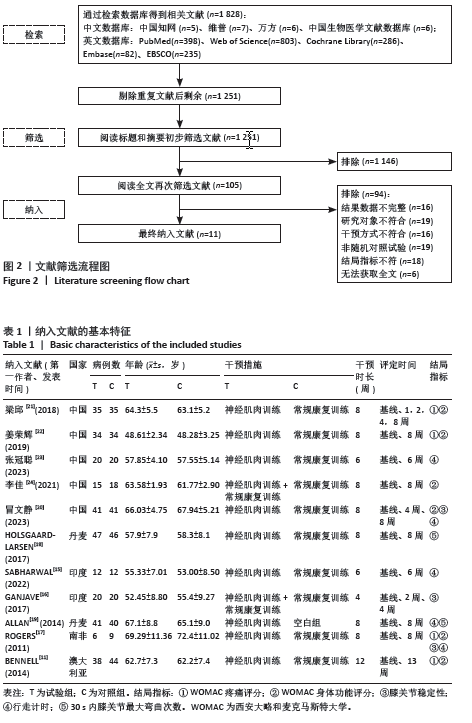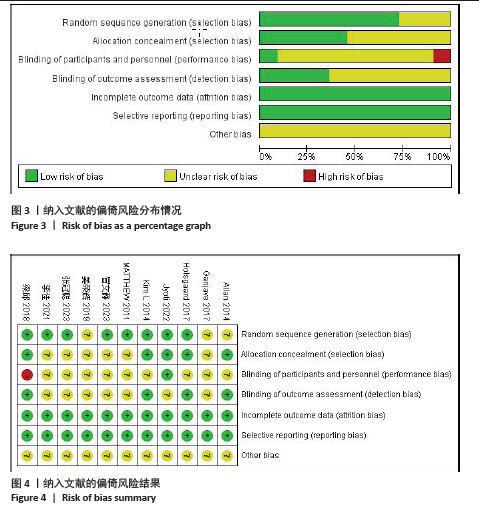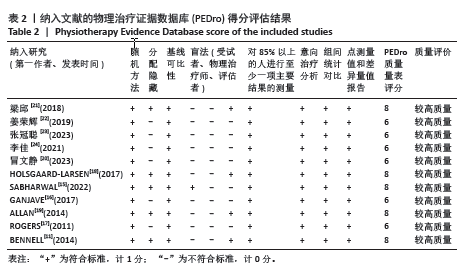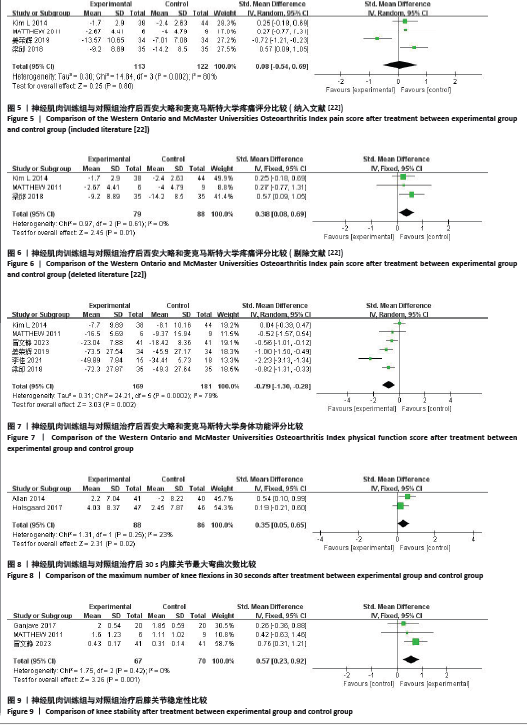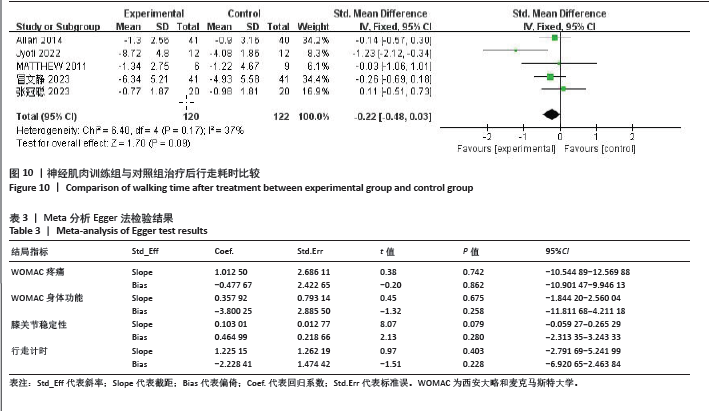[1] YE J, ZHENG Q, ZOU L, et al. Mindful Exercise (Baduanjin) as an Adjuvant Treatment for Older Adults (60 Years Old and Over) of Knee Osteoarthritis: A Randomized Controlled Trial. Evid Based Complement Alternat Med. 2020;2020:9869161.
[2] 程露露, 李冬静, 李梦醒,等. 针灸治疗膝骨性关节炎作用机制研究概况[J]. 中国骨质疏松杂志,2022,28(10):1514-1517,1540.
[3] 陈鉴冰, 叶倩云, 朱晓峰. 膝骨关节炎致病危险因素的meta分析[J]. 暨南大学学报(自然科学与医学版),2023,44(4):406-415.
[4] SUN X, ZHEN X, HU X, et al. Osteoarthritis in the Middle Aged and Elderly in China: Prevalence and Influencing Factors. Int J Environ Res Public Health. 2019;16(23):4701.
[5] AGEBERG E, ROOS EM. Neuromuscular exercise as treatment of degenerative knee disease. Exerc Sport Sci Rev. 2015;43(1):14-22.
[6] PRIMEAU CA, BIRMINGHAM TB, MOYER RF, et al. Trajectories of perceived exertion and pain over a 12-week neuromuscular exercise program in patients with knee osteoarthritis. Osteoarthritis Cartilage. 2020;28(11):1427-1431.
[7] CLAUSEN B, HOLSGAARD-LARSEN A, ROOS EM. An 8-Week Neuromuscular Exercise Program for Patients With Mild to Moderate Knee Osteoarthritis: A Case Series Drawn From a Registered Clinical Trial. J Athl Train. 2017;52(6):592-605.
[8] JUHL C, CHRISTENSEN R, ROOS EM, et al. Impact of exercise type and dose on pain and disability in knee osteoarthritis: a systematic review and meta-regression analysis of randomized controlled trials. Arthritis Rheumatol. 2014;66(3):622-636.
[9] HOLM PM, PETERSEN KK, WERNBOM M, et al. Strength training in addition to neuromuscular exercise and education in individuals with knee osteoarthritis-the effects on pain and sensitization. Eur J Pain. 2021;25(9):1898-1911.
[10] GANJAVE PD, DABHOLKAR T. Efficacy of Neuromuscular Training on Pain, Balance and Function in Patients with Grade I and II Knee Osteoarthritis. J Exerc Sci Physiother. 2017;13(2):27-40.
[11] BENNELL KL, KYRIAKIDES M, METCALF B, et al. Neuromuscular versus quadriceps strengthening exercise in patients with medial knee osteoarthritis and varus malalignment: a randomized controlled trial. Arthritis Rheumatol. 2014;66(4):950-959.
[12] ALTMAN R, ASCH E, BLOCH D, et al. Development of criteria for the classification and reporting of osteoarthritis. Classification of osteoarthritis of the knee. Diagnostic and Therapeutic Criteria Committee of the American Rheumatism Association. Arthritis Rheum. 1986;29(8):1039-1049.
[13] 中华医学会骨科学分会关节外科学组. 骨关节炎诊疗指南(2018年版)[J]. 中华骨科杂志,2018,38(12):705-715.
[14] MAHER CG, SHERRINGTON C, HERBERT RD, et al. Reliability of the PEDro scale for rating quality of randomized controlled trials. Phys Ther. 2003;83(8):713-721.
[15] SABHARWAL J, JOSHI S. Neuromuscular exercise with neuromuscular electrical stimulation in knee osteoarthritis: a randomised controlled pilot trial. 2022; 36(4):8‐16.
[16] GANJAVE PRANITA D, TWINKLE D. Efficacy of Neuromuscular Training on Pain, Balance and Function in Patients with Grade I and II Knee Osteoarthritis. Exerc Sci Physiother. 2017;13(2):27-40.
[17] ROGERS MW, TAMULEVICIUS N, COETSEE MF, et al. Knee Osteoarthritis and the Efficacy of Kinesthesia, Balance & Agility Exercise Training: A Pilot Study. Int J Exerc Sci. 2011;4(2):124-132.
[18] HOLSGAARD-LARSEN A, CLAUSEN B, SØNDERGAARD J, et al. The effect of instruction in analgesic use compared with neuromuscular exercise on knee-joint load in patients with knee osteoarthritis: a randomized, single-blind, controlled trial. Osteoarthritis Cartilage. 2017;25(4):470-480.
[19] VILLADSEN A, OVERGAARD S, HOLSGAARD-LARSEN A, et al. Immediate efficacy of neuromuscular exercise in patients with severe osteoarthritis of the hip or knee: a secondary analysis from a randomized controlled trial. J Rheumatol. 2014;41(7):1385-1394.
[20] 冒文静, 丁彬鸿, 吴素青. 神经肌肉训练对老年膝骨关节炎患者关节稳定性及下肢运动功能的影响[J]. 海军医学杂志, 2023,44(1):74-78.
[21] 梁邱, 何成奇, 姜俊良,等. 神经肌肉运动训练对膝骨关节炎患者的疼痛与功能恢复的临床疗效观察[J]. 华西医学,2018, 33(10):1247-1251.
[22] 姜荣辉. 神经肌肉运动训练对膝骨关节炎患者的疼痛与功能恢复的临床疗效观察[J]. 世界最新医学信息文摘,2019,19(97): 40-41.
[23] 张冠聪, 黄秋晨, 顾蕊,等. 不同神经肌肉训练方法对早期膝骨关节炎患者疼痛和运动功能效果的比较[J]. 中国康复理论与实践,2023,29(9):1090-1097.
[24] 李佳, 张鸿悦, 刘晓磊,等. 神经肌肉训练对重度膝骨关节炎患者膝关节功能和姿势控制的影响[J]. 中国临床医生杂志, 2021,49(3):315-317.
[25] 李志霞, 康玉闻, 刘永裕,等. 经筋灸法联合神经肌肉运动训练治疗膝骨关节炎的临床观察[J]. 中国医学创新,2021, 18(15):90-93.
[26] BLALOCK D, MILLER A, TILLEY M, et al. Joint instability and osteoarthritis. Clin Med Insights Arthritis Musculoskelet Disord, 2015;8:15-23.
[27] ZENG CY, ZHANG ZR, TANG ZM, et al. Benefits and Mechanisms of Exercise Training for Knee Osteoarthritis. Front Physiol. 2021;12:794062.
[28] MICHAEL JW, SCHLüTER-BRUST KU, EYSEL P. The epidemiology, etiology, diagnosis, and treatment of osteoarthritis of the knee. Dtsch Arztebl Int. 2010;107(9):152-162.
[29] BENNELL K, DOBSON F. Neuromuscular exercise for degenerative knees: can we optimize the treatment effect? Exerc Sport Sci Rev. 2015;43(1):3-4.
[30] THORSTENSSON CA, HENRIKSSON M, VON PORAT A, et al. The effect of eight weeks of exercise on knee adduction moment in early knee osteoarthritis-a pilot study. Osteoarthritis Cartilage. 2007;15(10):1163-1170.
[31] 胡浩宇. 神经肌肉训练技术对髌股疼痛综合症(PFPS)患者的疗效及其影响研究[D]. 上海:上海体育学院,2019.
[32] GLASS NA, TORNER JC, FREY LAW LA, et al. The relationship between quadriceps muscle weakness and worsening of knee pain in the MOST cohort: a 5-year longitudinal study. Osteoarthritis Cartilage. 2013;21(9):1154-1159.
[33] RASHID SA, MOIZ JA, SHARMA S, et al. Comparisons of Neuromuscular Training Versus Quadriceps Training on Gait and WOMAC Index in Patients With Knee Osteoarthritis and Varus Malalignment. J Chiropr Med. 2019;18(1):1-8.
[34] BECKWéE D, VAES P, CNUDDE M, et al. Osteoarthritis of the knee: why does exercise work? A qualitative study of the literature. Ageing Res Rev. 2013;12(1):226-236.
[35] DAINESE P, WYNGAERT KV, DE MITS S, et al. Association between knee inflammation and knee pain in patients with knee osteoarthritis: a systematic review. Osteoarthritis Cartilage. 2022;30(4):516-534.
[36] HUNTER DJ, BEAVERS DP, ECKSTEIN F, et al. The Intensive Diet and Exercise for Arthritis (IDEA) trial: 18-month radiographic and MRI outcomes. Osteoarthritis Cartilage. 2015;23(7):1090-1098.
[37] LESNAK JB, SLUKA KA. Mechanism of exercise-induced analgesia: what we can learn from physically active animals. Pain Rep. 2020;5(5):e850.
[38] STEIDLE-KLOC E, RABE K, ECKSTEIN F, et al. Is muscle strength in a painful limb affected by knee pain status of the contralateral limb -Data from the Osteoarthritis Initiative. Ann Anat. 2019;221:68-75.
[39] SANCHEZ-RAMIREZ DC, VAN DER LEEDEN M, KNOL DL, et al. Association of postural control with muscle strength, proprioception, self-reported knee instability and activity limitations in patients with knee osteoarthritis. J Rehabil Med. 2013;45(2):192-197.
[40] ZENG Z, SHAN J, ZHANG Y, et al. Asymmetries and relationships between muscle strength, proprioception, biomechanics, and postural stability in patients with unilateral knee osteoarthritis. Front Bioeng Biotechnol. 2022;10:922832.
[41] AGEBERG E, NILSDOTTER A, KOSEK E, et al. Effects of neuromuscular training (NEMEX-TJR) on patient-reported outcomes and physical function in severe primary hip or knee osteoarthritis: a controlled before-and-after study. BMC Musculoskelet Disord. 2013;14:232.
[42] BREMANDER AB, DAHL LL, ROOS EM. Validity and reliability of functional performance tests in meniscectomized patients with or without knee osteoarthritis. Scand J Med Sci Sports. 2007;17(2):120-127.
[43] URITANI D, KODA H, YASUURA Y, et al. Factors associated with subjective knee joint stiffness in people with knee osteoarthritis: A systematic review. Int J Rheum Dis. 2023; 26(3):425-436.
[44] ROOS EM, DAHLBERG L. Positive effects of moderate exercise on glycosaminoglycan content in knee cartilage: a four-month, randomized, controlled trial in patients at risk of osteoarthritis. Arthritis Rheum. 2005;52(11):3507-3514.
[45] ALESSANDRO C, PRASHARA A, TENTLER DP, et al. Inhibition of knee joint sensory afferents alters covariation across strides between quadriceps muscles during locomotion. J Appl Physiol (1985). 2023; 134(4):957-968.
[46] 李永杰, 扈盛. 水中运动训练对脑卒中患者下肢肢体功能和日常生活能力影响的meta分析[J]. 中国康复医学杂志, 2019,34(10):1209-1215.
[47] CHAHARMAHALI L, GANDOMI F, YALFANI A, et al. The effect of mindfulness and motivational interviewing along with neuromuscular exercises on pain, function, and balance of women affected by knee osteoarthritis: a rater-blinded randomized controlled clinical trial. Disabil Rehabil. 2023:1-12.
[48] BELLAMY N, BUCHANAN WW, GOLDSMITH CH, et al. Validation study of WOMAC: a health status instrument for measuring clinically important patient relevant outcomes to antirheumatic drug therapy in patients with osteoarthritis of the hip or knee. J Rheumatol.1988;15(12):1833-1840.
[49] PENG YL, JOHNSON AE, GRIFFIN L. Sex differences in neuromuscular control of quadriceps. Eur J Appl Physiol. 2020; 120(10):2193-2202.
[50] AMAN JE, ELANGOVAN N, YEH IL, et al. The effectiveness of proprioceptive training for improving motor function: a systematic review. Front Hum Neurosci. 2014;8:1075.
[51] IRISH SE, MILLWARD AJ, WRIDE J, et al. The effect of closed-kinetic chain exercises and open-kinetic chain exercise on the muscle activity of vastus medialis oblique and vastus lateralis. J Strength Cond Res. 2010;24(5):1256-1262.
[52] SLOBODOVÁ L, ORESKÁ Ľ, SCHÖN M, et al. Effects of Short- and Long-Term Aerobic-Strength Training and Determinants of Walking Speed in the Elderly. Gerontology. 2022;68(2):151-161.
[53] SAZO-RODRÍGUEZ S, MÉNDEZ-REBOLLEDO G, GUZMÁN-MUÑOZ E, et al. The effects of progressive neuromuscular training on postural balance and functionality in elderly patients with knee osteoarthritis: a pilot study. J Phys Ther Sci. 2017;29(7):1229-1235. |
